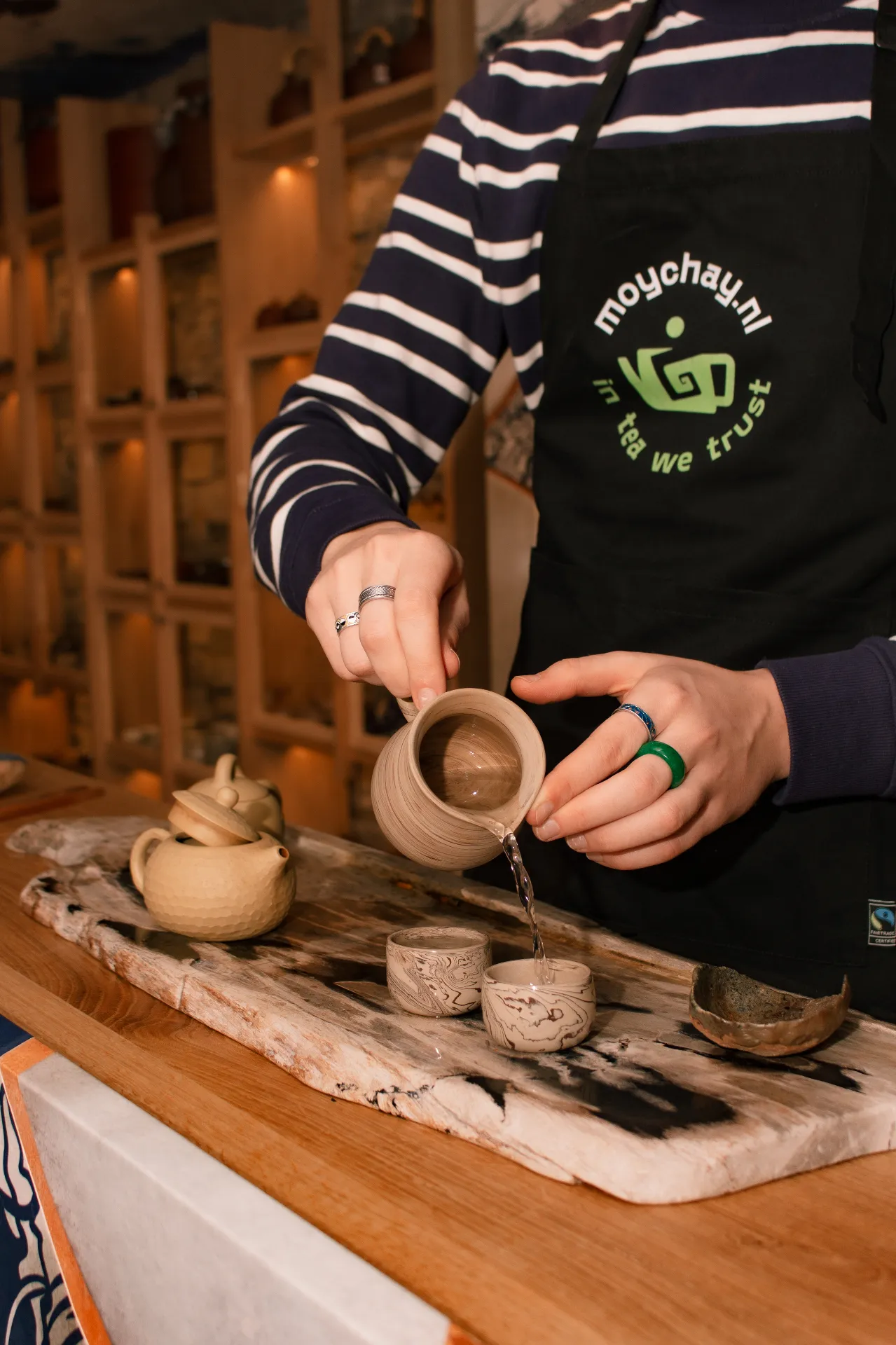
The Gongfu Cha ceremony, with its collection of delicate teaware and precise movements, often seems mysterious and reserved for seasoned experts. This can be intimidating, but the truth is much more welcoming. At its heart, Gongfu Cha is an accessible and deeply rewarding practice that offers a profound connection to your tea. Originating in the Chaozhou region of China and refined over centuries, this practice represents more than just brewing tea—it's a mindful way to "taste tea," creating intentional moments of calm and focus. This practical, step-by-step guide is designed to demystify the process and empower you, the curious beginner, to conduct your very first session with confidence.

Understanding the Philosophy of Gongfu Cha
The term 'Gongfu Cha' (功夫茶) literally translates to "tea with great skill or effort." But this effort isn't about complexity for its own sake—it's about intention and mindfulness. The core principles are presence, appreciation for the elements involved (the tea leaves, the water, the teaware), and creating a space for connection. As tea culture has shown us throughout history, tea contains beneficial nutrients and has been valued for its medicinal properties since at least the 3rd century AD. More than just a beverage, tea became a social ritual that brought different people together, developing into a multifaceted culture with rich historical depth.
One tea lover beautifully captured this spirit: "My life philosophy is simple - tea is worth spending time on it. Take your time. Make your teaware setting. Meet with friends. Enjoy life." This perspective reframes the ritual not as a chore, but as a non-negotiable part of life for creating intentional moments of peace and self-awareness.
Your Essential Toolkit: Must-Have Teaware for Beginners
Embarking on your Gongfu journey doesn't require an elaborate collection of teaware. Starting with a few key pieces allows you to focus on the process. Here are the fundamentals for a basic session:
- Gaiwan (蓋碗): This lidded bowl is the heart of the toolkit. A gaiwan is a lidded cup used for tea steeping and consumption, offering brilliant versatility for beginners. Unlike a teapot, its white porcelain interior allows you to clearly see the color of the infusion, and its wide opening lets you fully appreciate the aroma of the wet leaves.
- Gong Dao Bei (公道杯) or "Fairness Pitcher": After steeping, the tea is poured from the gaiwan into this small pitcher. Its role is to hold the entire infusion, ensuring that when you serve the tea into individual cups, everyone receives a brew of the same strength and flavor.
- Small Tasting Cups: Gongfu Cha is about savoring, not gulping. Small cups encourage you to take slow, mindful sips, allowing you to fully engage your senses and notice the subtle changes in the tea's taste and aroma with each infusion.
- Tea Tray (Chaban - 茶盤): This tray, often made of bamboo or clay, is designed to collect spills and the discarded water from rinsing the leaves and warming the cups. It provides a dedicated, clean space for your ceremony.
- Hot Water Source: A kettle with temperature control is ideal, as different teas require different water temperatures to bring out their best qualities. White tea is best brewed at 60-80°C (140-176°F), oolong teas at 90-97°C (194-206°F), and Pu-erh teas at around 95°C (203°F).
Explore Premium Gaiwans at Moychay.nl
Water Quality: The Foundation of Great Tea
The importance of water quality in Gongfu Cha cannot be overstated. Use spring or well water when possible, as tap water's mineral content can vary significantly and affect the tea's taste. If tap water is your only option, filter it to remove chlorine and other impurities that can interfere with the tea's natural flavors. The water should be heated to the appropriate temperature for your specific tea type.

Mastering the Steps: A Guided Walkthrough for Your First Session
With your space prepared and your tools assembled, you're ready to begin. Remember, these steps are a guide, not a rigid script. The joy is in experimentation and finding your own rhythm.
- Prepare Your Space & Teaware: Find a calm, uncluttered space. Arrange your teaware on the chaban. Pre-heat your tools by pouring hot water over the gaiwan, pitcher, and cups. Discard this water into the tea tray. This ensures the tea's temperature remains stable during brewing.
- Introduce the Tea: Add your chosen tea leaves to the warmed gaiwan. A good starting point is a high tea-to-water ratio, typically around 5-7 grams of tea per 100ml of water. Take a moment to appreciate the aroma of the dry leaves.
- Awaken the Leaves: Perform a "rinse" by pouring hot water over the leaves just enough to cover them, using circular motions, then immediately pouring the water out. This brief infusion is discarded and helps open up compressed leaves.
- The First Infusion: Fill the gaiwan with hot water and steep for 5-15 seconds. The goal is to taste the tea's evolution over many infusions, not to extract everything at once. Carefully pour the entire contents into your Gong Dao Bei.
- Serving & Savoring: From the Gong Dao Bei, distribute the tea evenly into the tasting cups. Now, slow down. Appreciate the color, inhale the fragrant steam, and take a small, mindful sip. Notice the flavors and the feeling of the tea in your mouth.
- Subsequent Infusions: Repeat the process, gradually increasing the steeping time by 10-15 seconds with each subsequent pour. Pay attention to how the tea's character changes—the aroma may shift, and new flavor notes may emerge. This beautiful transformation is the essence of Gongfu Cha.
Recommended Teas for Gongfu Cha: Oolongs and Pu-erhs
The Gongfu method truly shines with teas that have complex, layered profiles. Oolongs and Pu-erhs are classic choices because their flavors develop beautifully over multiple short infusions.

Oolong Teas: The Perfect Starting Point
Oolongs are renowned for their ability to withstand many steepings, with each pour revealing a new dimension of their character. Low-oxidation oolongs (25-40 percent) include South Fujian and Taiwan teas with small "wrap-curled" beads that are green with yellow and purple shades. The tea liquor is golden green, with strong fragrant aroma and rich aftertaste tones called Huigan (pleasant returning sweetness) and Houyun (throat rhyme). High-mountain tea can be steeped from 7 to 15 times, making them ideal for extended Gongfu sessions.
Good starting oolongs include the floral and bright Tie Guan Yin or the deep, roasted Da Hong Pao. For a truly calming session, a GABA Oolong, processed in an altitude chamber for 30 minutes to 10 hours to increase GABA content to 150 mg/100g, offers unique soothing properties.
Pu-erh Teas: A Journey Through Time
Pu-erhs offer a completely different but equally rewarding experience. These aged and fermented teas from Yunnan province have rich, earthy notes that change dramatically from one steeping to the next. Sheng (raw) Pu-erh is made from mao cha with a moisture content of 8-12 percent and ages naturally over time, with tartness changing to sweetness and sharp taste becoming more versatile. Shou (ripe) Pu-erh undergoes controlled fermentation (Wo Dui) in humidity-controlled rooms for 2-8 hours, creating dark, smooth characteristics.
Understanding the grading system helps in selection: Gongting (Imperial grade) features small, thin, straight wisps of twisted buds with golden hairs, giving bright dark red liquor with mature, rich aroma. Te Ji (highest grade) and Yi Ji (first grade) offer similar qualities with slight variations in appearance and strength.
Explore Sheng and Shou Pu-erh Collection
The Cultural Heritage and Modern Adaptation
Gongfu Cha represents more than just a brewing method—it's a window into centuries of Chinese tea culture and philosophy. The practice has been refined through generations, with tea culture offering the potential for personal growth and social connection. As tea culture spreads globally, it provides a fruitful alternative to other forms of social gathering, much like yoga and meditation have become rich cultural hubs where people can connect and enrich their lives together.

Common Beginner Questions Answered
As you begin your Gongfu Cha journey, you may have questions about proper technique and tea care:
- How do I know if my tea has deteriorated? Fresh tea should have a vibrant aroma and clear flavor. If your tea tastes musty, flat, or develops off-flavors, it may have been improperly stored.
- How should I store opened tea? Keep tea in airtight containers away from light, moisture, and strong odors. Different teas have different storage requirements—Pu-erh benefits from some air circulation for natural aging, while green teas should be kept completely airtight.
- What if I don't have exact water temperature? While precise temperatures help optimize flavor, don't let this prevent you from practicing. Start with what you have and refine your setup over time.
Moychay.nl: Your Partner in Deepening Your Tea Journey
At Moychay.nl, our commitment is to support you through every stage of your tea journey. We are more than an online shop; we are curators of a mindful lifestyle, dedicated to helping beginners feel empowered and inspired. Our educational guidance and brewing tips are designed to eliminate guesswork and build your confidence. We offer complete tea journey support, meaning you can find everything you need in one place, from your first gaiwan to connoisseur-grade aged teas.
For over 12 years, we have been pioneering tea culture, culminating in our physical tea house in Amsterdam. If you are in the city, we warmly invite you to visit, explore our collection in person, and receive personal recommendations from our knowledgeable Tea Guides.
Complete Your Teaware Collection
Conclusion: Embrace Your Mindful Tea Practice
Gongfu Cha is not about achieving perfection. It is a personal journey of discovery, mindfulness, and presence. Every session is a new opportunity to learn about your tea and to connect with yourself. The most important thing is to begin. Embrace the sensory experience, savor the quiet moments, and allow this enriching ritual to bring a sense of calm and intention into your daily life.
Consistency, not flawlessness, is what builds a rewarding practice. Your journey into mindful brewing starts now. Embrace the ritual, savor the moment, and discover a deeper connection with your tea.
- Shop Premium Teas: Explore over 350 personally selected loose-leaf teas for your Gongfu practice.
- Essential Teaware: Browse our collection of gaiwans, pitchers, and complete brewing sets.
- Experience Sets: Perfect starter collections combining premium teas with matching teaware.




